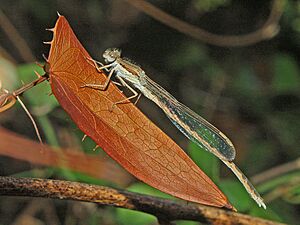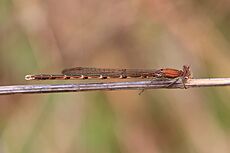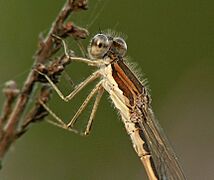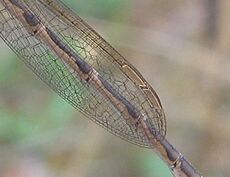Common winter damselfly facts for kids
Quick facts for kids Common winter damselfly |
|
|---|---|
 |
|
| Male Kampinos Forest, Poland |
|
 |
|
| Scientific classification | |
| Genus: |
Sympecma
|
| Species: |
fusca
|
| Synonyms | |
|
List
Agrion fuscum Vander Linden, 1820
Agrion phallatum Charpentier 1825 Lestes fusca Selys & Hagen 1850 Sympecma aragonensis Navás, 1927 |
|
The Sympecma fusca, also known as the common winter damselfly, is a type of damselfly. It belongs to the Lestidae family, which includes insects often called emeralds or spreadwings.
Contents
Where They Live and What They Like
This damselfly can be found across much of southern and central Europe. Its range extends into Asia, where a similar species, S. paedisca, takes its place. You can spot them around the Mediterranean Sea, including in Europe, North Africa, and on many Mediterranean islands.
Common winter damselflies live near all kinds of still water, even water that is a bit salty. When winter arrives, the adult damselflies move away from the water. They often hide on dry plant stems in open areas like grasslands and heaths.
There have only been two recorded sightings of this species in Britain. The first was on December 21, 2008, in Southeast Wales. The second was seen by Terry Crow on May 5, 2022, at Wildern Moor in Hedge End.
What They Look Like
The Sympecma fusca can grow to be about 38 millimeters long. It looks different from most other damselflies in Europe, except for Sympecma paedisca. This means it's usually easy to tell apart from other damselflies in most places.
Unlike many damselflies, it doesn't have bright blue or red colors. This is why people sometimes don't notice them. Also, it doesn't have the shiny, metallic green color that is common for damselflies in the Lestes group.
These damselflies have pale brown spots on their wings called pterostigma. These spots are on both their front and back wings. The pterostigma on the front wing is closer to the wing tip. This means you can see both pterostigma when the damselfly's wings are closed. They don't overlap like they do in other damselflies. This is a clear way to tell Sympecma damselflies apart from all others. Males that have lived through the winter often have dark brown pterostigma and their eyes might turn blue.
If both S. fusca and S. paedisca live in the same area, it can be tricky to tell them apart. You might need to look very closely at the adult damselfly, perhaps even with a magnifying glass. Males have slightly different parts at the end of their bodies. Also, there are small differences in the markings on the chest area of both males and females.
Life Cycle and Behaviour
This damselfly is special because it lives through the winter as an adult insect. It usually blends in very well with the dry grass stalks where it spends the colder months. The common winter damselfly is one of only two types of European dragonflies that survive winter as adults. The other is its relative, Sympecma paedisca. Even though they are related to the Lestes damselflies, which are called 'spreadwings' because they rest with their wings open, Sympecma damselflies rest with their wings held close to their bodies.
In the spring, these damselflies find mates. The female then lays her eggs in floating plants, often with the male still attached. Most of this egg-laying happens in April and May. The eggs hatch, and the young damselflies, called larvae, grow quickly in about two months. Once the adult damselflies emerge, they fly away from the water. They often go to heathlands or grasslands far from water, where they will hide among dry plant stems to spend the winter.
Gallery
See also
- List of damselflies of the world (Lestidae)
- Lestes dryas
- Lestes barbarus
- Lestes virens
- Lestes macrostigma
- Lestes viridis
- Lestes parvidens




